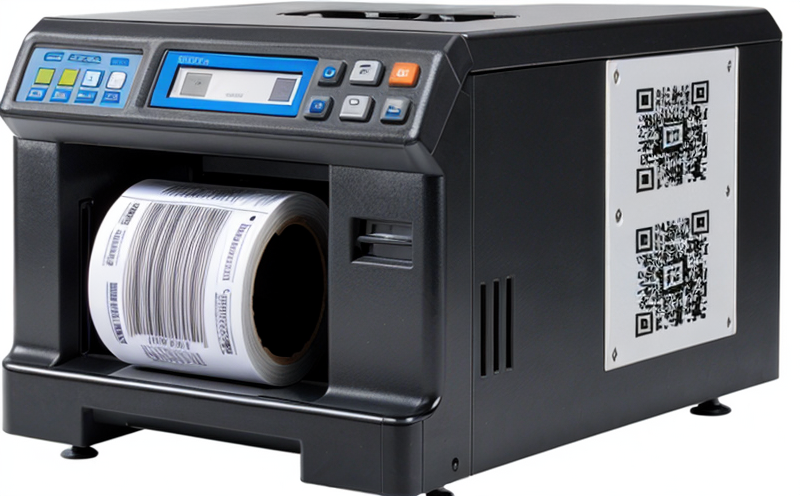ASTM D6626 Ink Smear Resistance Test
The ASTM D6626 Ink Smear Resistance Test is an essential procedure used in packaging laboratories to evaluate the resistance of printed ink, labels, and barcodes against smears. This test ensures that the applied printing remains intact during various stages of a product's lifecycle, from manufacturing to storage and handling by consumers.
The test measures how well the ink can withstand contact with surfaces such as hands, packaging materials, or other products. It is particularly crucial for ensuring that barcodes remain readable under real-world conditions. The ASTM D6626 test is widely recognized in industries like food, pharmaceuticals, and consumer goods, where label integrity directly impacts product safety and traceability.
The procedure involves preparing a printed specimen according to the specified dimensions outlined in ASTM D6626. The inked area is then subjected to repeated contact with a standardized rubbing surface. After a predetermined number of cycles, the extent of smearing or loss of print quality is visually assessed. The test can also include quantitative measurements using spectrophotometric instruments if required.
This test ensures that labels and barcodes are not only aesthetically pleasing but also functional. In real-world applications, this means that important information such as batch codes, expiration dates, or product identification numbers remain legible throughout the supply chain. The ASTM D6626 standard helps manufacturers comply with regulatory requirements by ensuring their packaging meets durability standards.
The ASTM D6626 ink smear resistance test is not just a quality check; it's an integral part of a broader strategy to enhance product safety and consumer trust. By adhering to this test, companies can demonstrate that they are committed to producing high-quality products that meet industry best practices. This commitment extends beyond the laboratory into every step of the manufacturing process.
For instance, in the food packaging sector, ensuring ink smear resistance is critical for maintaining product integrity and preventing contamination from external sources. In pharmaceutical packaging, it ensures that important labeling information remains visible to healthcare professionals and patients.
Why It Matters
The importance of the ASTM D6626 Ink Smear Resistance Test cannot be overstated in today's competitive market. Consumers expect products to be safe, reliable, and easy to use. Any damage or smudging of printed labels can lead to confusion, safety concerns, and ultimately, loss of consumer trust.
- Enhanced Consumer Trust: Clear and legible labels build confidence in the product's quality and safety.
- Regulatory Compliance: Meeting ASTM D6626 ensures compliance with international standards, avoiding potential penalties or recalls.
- Durability: The test helps ensure that packaging remains intact during transport and handling, protecting products from damage.
- Product Integrity: By preventing ink smear, the test guarantees accurate product identification and traceability throughout the supply chain.
In industries like pharmaceuticals and food, where mislabeling can have severe consequences, the ASTM D6626 test is a cornerstone of quality assurance. It helps manufacturers maintain their reputation for producing high-quality products that meet stringent standards.
Why Choose This Test
Selecting the ASTM D6626 Ink Smear Resistance Test offers several advantages over other testing methods. Firstly, it is a standardized procedure recognized globally, ensuring consistency in results across different laboratories and regions. This standardization facilitates easier comparison of data between companies and regulatory bodies.
- Global Recognition: ASTM D6626 is widely accepted by industry leaders, regulatory agencies, and consumers worldwide.
- Consistency: The test ensures uniformity in the evaluation process, making it easier to replicate results across different facilities.
- Precision: With defined parameters for specimen preparation and testing cycles, the ASTM D6626 provides precise data that can be used to improve product design and manufacturing processes.
- Compliance: By adhering to this test, companies ensure they meet international standards, reducing the risk of non-compliance issues.
The ASTM D6626 Ink Smear Resistance Test also offers flexibility. It can be customized to suit specific product requirements, ensuring that labels and barcodes are optimized for their intended use. This adaptability makes it a valuable tool in research and development departments where innovation is key.
Quality and Reliability Assurance
The ASTM D6626 Ink Smear Resistance Test plays a crucial role in ensuring the quality and reliability of packaging materials, labels, and barcodes. By subjecting printed specimens to repeated contact with rubbing surfaces, this test reveals any potential weaknesses in ink adhesion.
- Adhesion Strength: The test helps identify how well the ink adheres to the substrate material. Poor adhesion can lead to smudging or peeling of labels under normal conditions.
- Material Compatibility: It also evaluates whether the ink is compatible with various types of substrates, ensuring that it performs consistently across different packaging materials.
- Ink Deterioration: Over time, exposure to environmental factors like moisture or temperature can cause ink deterioration. The ASTM D6626 test helps monitor this process and identify potential issues early on.
The results of the ASTM D6626 Ink Smear Resistance Test are critical for quality assurance teams in packaging laboratories. They provide valuable insights into the performance of printed materials, helping companies make informed decisions about their product design and production processes.





